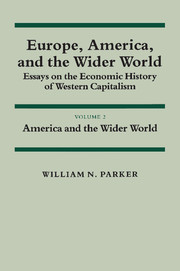Book contents
- Frontmatter
- Contents
- Editors' preface
- Preface
- Acknowledgments
- A note on notes
- PART I AMERICA AND EUROPE: A HISTORY
- PART II THE SOUTH IN SLAVERY AND IN FREEDOM
- PART III CAPITALIST DYNAMICS OF THE RURAL NORTH
- PART IV THE NORTH: DYNAMICS OF AN INDUSTRIAL CULTURE
- 11 New England: the Puritan progenitor
- 12 The industrial civilization of the Midwest
- PART V AMERICAN VALUES IN A CAPITALIST WORLD
- ANNEXES
- Index
12 - The industrial civilization of the Midwest
Published online by Cambridge University Press: 06 December 2010
- Frontmatter
- Contents
- Editors' preface
- Preface
- Acknowledgments
- A note on notes
- PART I AMERICA AND EUROPE: A HISTORY
- PART II THE SOUTH IN SLAVERY AND IN FREEDOM
- PART III CAPITALIST DYNAMICS OF THE RURAL NORTH
- PART IV THE NORTH: DYNAMICS OF AN INDUSTRIAL CULTURE
- 11 New England: the Puritan progenitor
- 12 The industrial civilization of the Midwest
- PART V AMERICAN VALUES IN A CAPITALIST WORLD
- ANNEXES
- Index
Summary
RESOURCES AND TECHNOLOGY
After 1860, colonization in the American Midwest proceeded rapidly across the Mississippi River and by 1890 had encompassed the Prairies and Great Plains. At the same time, the population east of the Mississippi grew thicker, and the agro-business culture, with its small towns and manufactures, grew denser and more complex. This was accompanied by the growth of geographical and technical knowledge – a knowledge which, under the rules and forms of capitalist enterprise, was rather quickly translated into economic opportunity. In the Far West prospectors were alert for news of a minerals strike and responded with the classic “rush.” On the Plains, beginning in Texas and moving north, cattlemen organized drives through newly opened grasslands and developed within the next few decades complex combinations of ranching, transportation and stall feeding to move the meat to middle western markets. Farmers, set loose into free land by the Homestead Act of 1862 and into cheap land on the enormous domains of the railroad grants, overcame an initial hesitation at venturing away from the forested areas and rapidly threw together whatever shelter they could build to make farms on the Plains and Prairies to raise corn and wheat on the rich soils beneath the grass.
- Type
- Chapter
- Information
- Europe, America, and the Wider WorldEssays on the Economic History of Western Capitalism, pp. 215 - 258Publisher: Cambridge University PressPrint publication year: 1991

